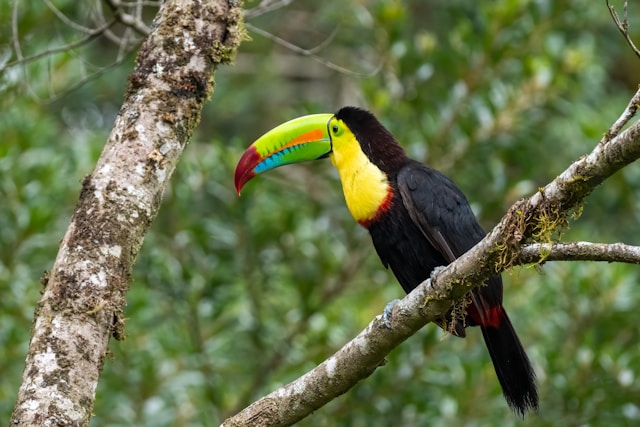Nestled within the lush tropical rainforests of Belize resides a creature of captivating beauty and distinctive allure: the Keel-billed Toucan. With its vibrant plumage and iconic bill, this avian marvel stands as a symbol of the rich biodiversity and natural wonders that define Belize’s landscape. Join us on a journey to unravel the secrets of the Keel-billed Toucan, from its colorful charm to its melodic calls, and discover the vital role it plays as a guardian of Belize’s precious rainforest ecosystem.
The Iconic Bill: Unraveling the Keel-billed Toucan’s Colorful Charm
The Keel-billed Toucan’s mesmerizing appearance is crowned by its iconic bill, a striking feature that captivates onlookers and sets it apart as one of nature’s most visually stunning creations. Measuring about a third of its body length, the toucan’s bill is not just a marvel of aesthetics but also serves several vital functions in its daily life.
First and foremost, the bill’s vibrant hues of green, yellow, orange, and red make it a standout feature in the dense greenery of Belize’s rainforests. This colorful display isn’t just for show; it plays a crucial role in communication and species recognition among toucans. Through their bill colors and patterns, toucans convey important information about their age, sex, and overall health, aiding in social interactions and mate selection within their communities.
Beyond its visual appeal, the Keel-billed Toucan’s bill is a multifunctional tool that facilitates various aspects of its survival. Despite its large size and seemingly cumbersome appearance, the bill is surprisingly lightweight due to its unique construction of hollow bone covered with keratin, the same material found in human fingernails. This adaptation allows the toucan to maneuver its bill with precision, whether it’s foraging for food or building nests in tree hollows.
One of the most fascinating aspects of the toucan’s bill is its role in feeding. Despite its size, the bill is incredibly dexterous, allowing the toucan to pluck fruits from tree branches with ease. Its serrated edges aid in gripping slippery surfaces, while the sharp tip helps in piercing through tough fruit skins. This specialized tool not only sustains the toucan’s diet primarily consisting of fruits but also enables it to feed on a wide range of other items, including insects, small reptiles, and even bird eggs when opportunities arise.
In essence, the Keel-billed Toucan’s colorful bill is not just a visual spectacle but a marvel of evolution, perfectly adapted to its life in the vibrant rainforests of Belize.
A Symphony of Calls: Understanding the Keel-billed Toucan’s Distinctive Vocalizations
The Keel-billed Toucan’s presence in the Belizean rainforests is not just a visual delight but also a symphony of distinctive vocalizations that echo through the dense canopy. These melodious calls serve multiple purposes, from communication within toucan flocks to establishing territorial boundaries and courtship displays.
One of the most recognizable sounds in the toucan’s repertoire is its series of croaking and yelping notes, often heard during the early morning and late afternoon hours. These vocalizations are part of the toucan’s social interactions, signaling its presence to other toucans in the vicinity and maintaining group cohesion within the flock. The complexity of these calls can vary depending on the context, conveying messages about food availability, potential threats, or simply maintaining contact with flock members while foraging through the forest canopy.
Apart from social communication, the Keel-billed Toucan’s calls also play a crucial role in defending its territory. Male toucans, in particular, are known for their loud and resonant calls, which they use to assert dominance and deter rival males from encroaching on their nesting sites or preferred foraging areas. These territorial calls serve as a clear warning to potential intruders, signaling the toucan’s readiness to defend its space if necessary.
During the breeding season, the toucan’s vocal repertoire takes on a new dimension as males engage in elaborate courtship displays to attract females. These displays often involve a combination of vocalizations, bill movements, and aerial acrobatics, showcasing the male’s fitness and suitability as a mate. The female toucans, in turn, respond to these displays with their own calls, indicating their receptiveness to mating and reinforcing pair bonding within the species.
Overall, the Keel-billed Toucan’s distinctive vocalizations are not just sounds of the rainforest but a complex language that facilitates social interactions, defends territories, and strengthens bonds within toucan communities, adding another layer of fascination to these already captivating birds.
Guardian of the Rainforest: The Keel-billed Toucan’s Role in Belize’s Ecosystem
As a resident of Belize’s tropical rainforests, the Keel-billed Toucan plays a vital role in maintaining the delicate balance of its ecosystem. Often referred to as the “gardener of the forest,” these charismatic birds contribute significantly to seed dispersal, plant diversity, and overall ecosystem health.
One of the key contributions of the Keel-billed Toucan is its role as a seed disperser. By consuming a variety of fruits and berries, the toucan ingests seeds along with its food. These seeds then pass through the toucan’s digestive system unharmed and are deposited in different locations through its droppings. This process, known as endozoochory, helps in the dispersal of seeds across the forest, promoting plant regeneration and contributing to the diversity of plant species in various habitats.
The toucan’s foraging behavior also benefits the forest by influencing plant distribution. As they feed on fruits from different tree species, toucans move between trees and areas, spreading seeds from one location to another. This movement helps in creating new plant colonies and supports the natural regeneration of forested areas, especially in disturbed or deforested regions where seed dispersal mechanisms may be limited.
In addition to seed dispersal, Keel-billed Toucans play a role in controlling insect populations within their habitat. While fruits and berries constitute a significant part of their diet, toucans also consume insects, including beetles, ants, and termites. By preying on these insects, toucans help in regulating their populations, which can have cascading effects on plant health and ecosystem dynamics.
Furthermore, the presence of toucans in the canopy has been linked to increased biodiversity in the understory and forest floor. Their activities, such as nest building and foraging, create microhabitats that support a variety of organisms, including other bird species, mammals, reptiles, and invertebrates. This interconnected web of life highlights the importance of Keel-billed Toucans as ecosystem engineers, shaping the biodiversity and resilience of Belize’s rainforests.
Final Thoughts: Embracing the Keel-billed Toucan’s Legacy
The Keel-billed Toucan, with its vibrant plumage, iconic bill, melodious calls, and crucial ecological roles, stands as a testament to the intricate web of life that thrives within Belize’s tropical rainforests. Beyond its ornamental beauty, this charismatic bird embodies the essence of resilience, adaptation, and interconnectedness that defines thriving ecosystems.
As we delve into the world of the Keel-billed Toucan, we uncover not just a colorful creature but a guardian of biodiversity. Its contributions as a seed disperser, plant influencer, insect regulator, and habitat creator underscore the intricate dance of life within the rainforest. Each call echoes not only through the canopy but resonates through the interconnected relationships that sustain this lush environment.
The story of the Keel-billed Toucan is not just a narrative of natural history but a call to action. It reminds us of the delicate balance we must preserve, the habitats we must protect, and the species we must cherish. The toucan’s presence symbolizes the resilience of nature when given the opportunity to thrive, highlighting the importance of conservation efforts in safeguarding our planet’s biodiversity.
As we bid farewell to the Keel-billed Toucan in this exploration, let us carry forward its legacy of beauty, functionality, and ecological significance. May we continue to marvel at the wonders of nature, advocate for conservation practices, and embrace our role as stewards of this magnificent planet we call home.




